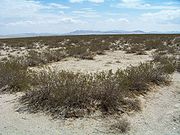
King Clone
Encyclopedia

Mojave Desert
The Mojave Desert occupies a significant portion of southeastern California and smaller parts of central California, southern Nevada, southwestern Utah and northwestern Arizona, in the United States...
is estimated to be 11,700 years old. It is considered one of the oldest living organisms on Earth. This single clonal colony
Clonal colony
A clonal colony or genet is a group of genetically identical individuals that have grown in a given location, all originating vegetatively from a single ancestor. In plants, an individual in such a population is referred to as a ramet...
plant of Larrea tridentata reaches up to 67 feet (20.4 m) in diameter, with an average diameter of 45 feet (13.7 m).
Geography
The King Clone ring is on restricted-access public land in the central Mojave Desert, approximately 0.6 miles north of California Route 247 on Bessemer Mine Road near the towns of Lucerne ValleyLucerne Valley, California
Lucerne Valley is a census-designated place located in the Mojave Desert of western San Bernardino County, California. It lies east of the Victor Valley, whose population nexus includes Victorville, Apple Valley, and Hesperia...
and Landers
Landers, California
Landers is an unincorporated community in San Bernardino County, California. The town lies in the Homestead Valley of the Mojave Desert, northeast of Flamingo Heights. The closest large towns are Yucca Valley and Joshua Tree. The town has its own small airport, Landers Airport.Near Landers is Giant...
. It is within the Creosote Rings Preserve of the Lucerne Valley and Johnson Valley.
Dating methodology
King Clone was identified and the 11,700 years old age documented by Frank Vasek, a professor at the University of California, RiversideUniversity of California, Riverside
The University of California, Riverside, commonly known as UCR or UC Riverside, is a public research university and one of the ten general campuses of the University of California system. UCR is consistently ranked as one of the most ethnically and economically diverse universities in the United...
. After Vasek hypothesized that the creosote ring was in fact one organism, Leonel Sternberg (then a graduate student working in Vasek's lab), was able to show that plants in a ring had some identical characteristics, but those shared characteristics differed from other plant clusters. Vasek then used two methods to determine the age of the ring. One method counted rings
Dendrochronology
Dendrochronology or tree-ring dating is the scientific method of dating based on the analysis of patterns of tree-rings. Dendrochronology can date the time at which tree rings were formed, in many types of wood, to the exact calendar year...
and measured the distance of annual growth, and the other used radiocarbon dating
Radiocarbon dating
Radiocarbon dating is a radiometric dating method that uses the naturally occurring radioisotope carbon-14 to estimate the age of carbon-bearing materials up to about 58,000 to 62,000 years. Raw, i.e. uncalibrated, radiocarbon ages are usually reported in radiocarbon years "Before Present" ,...
on chunks of wood found in the center of the ring, and measuring their distance from each other and the living bushes. Both dating methods yielded the same result.

